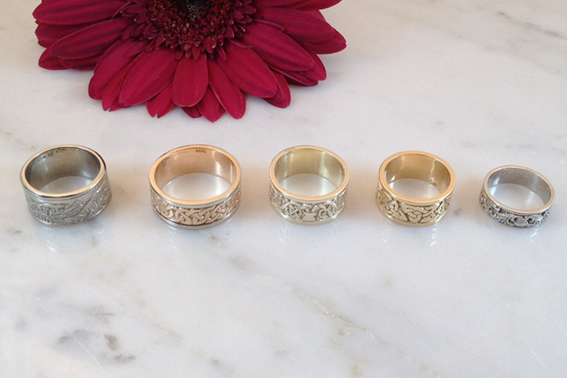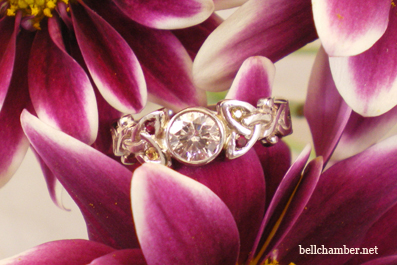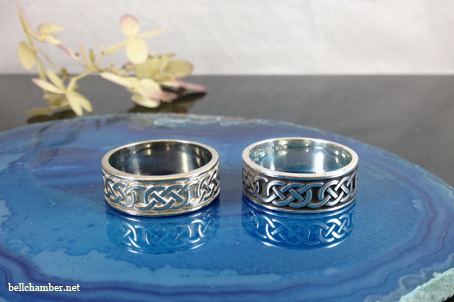

Rings - Pendants - Crosses - Bracelets - Earrings - Repairs - Contact
Home
![]()
|
Bellchamber Rings Frequently Asked questions and Guide to Ordering
Models of the rings are from left; Tsunami Wave (White Gold), Dimma Loveknot (Rose and White), Celtic Tree of Life (Green Gold), Eternity Triskele (Yellow Gold) and Medieval Tree of Life (Platinum). Colours/Colors of Gold are made by adding different elements to pure gold. Bellchamber Rings makes the coloured golds from the elements Copper, Silver, Gold, Nickel, Zinc and Platinum. Notice in the photo above that White Gold is a warm white, Rose gold is a rosy/yellow, Green Gold is a pale yellow/green, Yellow Gold is a bright Yellow (not as deep yellow as pure gold) and Platinum is a grey white colour. Click the here for a larger more detailed photo.
(Above Dianne Loveknot with Diamond) Q1. How long does an order take? JB-Expect 4-6 weeks for a custom order to get to you. Q2. What are the prices in US$ or my countries currency? JB- www.xe.com is a website I frequent for up to the minute exchange rates on world currencies. All of my prices are in Canadian dollars because I live in Canada. Q. What is 7mm in inches? JB- Generally a 6-7mm ring is 3/16" and 10 mm is about 1/4" wide. For further conversion tools an excellent website is here with Metric to Imperial. Q3. How do I find out my ring size? JB- Any reputable jewellery store will size your ring free of charge, ask the store clerk to size your finger with a 5mm or wider ring sizer. Q4. What is a sizing bar on your ring? JB- I prefer to make my rings with a pattern that is 'interrupted' with a small 2-3mm plain space at the back of the ring. This space provides a small area where any goldsmith can size your ring with ease. Q5. How long will the pattern last on my ring. JB- I guarantee the patterns in my Gold rings for 10 years and in my Silver rings for 5 years. Nothing is indestructible, treat your rings like they are pieces of art and the patterns should last a lifetime. Q6. Will my finger stay the same size for my life? JB- It is very rare that your fingers will stay the same size. Look at your parents hands and how big they where when you were young. Fingers usually change size every 5 - 10 years. More often then not they get larger due to your knuckles being cartilage. I will size a ring I make free of charge the first time you need it. No matter how long you've owned it.
Q7. What is Antiqued Silver? JB- Silver oxidizes naturally and antiquing is when the recessed areas are oxidized to a dark grey and the Surface is polished providing a contrast to highlight the design. Some manufacturers Rhodium Plate Silver or White gold Jewellery to make it a uniform colour but it wears off since it is only plated. I can make rings that are initially not antiqued but the recessed areas will oxidize over years. Q8. Why does Silver Turn my finger Green? JB- Sterling Silver oxidizes when in a more alkaline enviroment (Bleach is very Alkaline) and with about 1 in 6 people the salt in their persperation will oxidize the inside of a ring or where it's being worn on their finger. This rarely happens with a 10K gold as well where it can antique due to an alkaline skin. Q9. What is karat? JB- Karat refers the amount of gold in a piece of jewellery. The number you see with a K beside it, is the amount of gold divided by 24. Ie. A 14K Ring is 14/24 parts gold and 10/24 parts Alloy. In North America, so long as gold is the major component of an item it is considered to be gold still. Q10. Does pure white gold exist. Like 24K White Gold? JB- No. 10K, 14K or 18K White gold is gold, just like 10K, 14K or 18K yellow gold is gold. Gold in it’s pure state is referred to as 24K and is always the deep yellow of Gold. The Karat is the amount of pure gold divided by 24. When an alloy is added to pure gold it is a compound. Different alloys produce different characteristics such as colour, hardness and melting points etc. 22K Gold can only be yellow in colour. Q11. Is White Gold found in the ground that way? What is an alloy? JB-No. What makes white Gold white is the alloy that is added to the pure Gold. An alloy is a compound or element that is added to a metal in order to change its characteristics. It is added by melting them together under a flame. Most often the alloy consists of White Brass (Nickel, Copper and Zinc) or a more expensive white gold can be achieved by using the element Palladium.
Above two of the exact same model of ring. 14K white gold on the left and sterling silver on the right.
Q12. What is antiquing or a patina?
JB- Sterling silver is a compound of 92.5% Silver and 7.5% Copper. Over a long time the surface of silver will tarnish to a dark grey. This is known chemically as oxidation and in the jewellery trade is called a 'patina'. With silver jewellery the upper surface polishes slightly when we wear it, the lower surface of a design will naturally oxidize to a dark grey so that the detail is contrasted. This is called 'antiquing', because it looks somewhat aged. Gold jewellery will not oxidize under normal conditions. Usually the background is left with a textured finish and the top surface has a high polish. Q13. Why does white Gold sometimes looks not so white? JB-In terms of colour difference Palladium alloyed Gold will produce a grey white (closer to platinum) and White Brass will make a warmer white gold. Silver is the whitest metal, which is why it is used in Jewellery, however it oxidizes. Next to silver white gold items do not look as white; next to yellow gold they do look white. Mass producing manufacturers will often plate their white gold jewellery with Rhodium, which is an element that is a brighter white than Palladium or White Brass. The only drawback is that metal plating is not permanent, and on a ring especially, it will need to be replated every year or so. I prefer not to Rhodium Plate Bellchamber Rings. Rhodium plating is available for $50. It is hard and durable however, because it is plating it does wear over time, especially at the back of the ring due to your hand grasping metal objects etc. It usually shows a sign of wear after 2 years. If you are wearing the rings beside one ring another they will rub together and wear at small spots faster than not.
Expect to re rhodium every 2 years or so.
In my opinion I prefer the look of white gold without rhodium.. Q14. What are the most common alloys of gold? JB-Yellow Gold in 10K-18k generally is made up of (40%) Silver and (60%) Copper added to pure Gold. White Gold in 10K-18K is either White Brass (Nickel, Copper and Zinc) or Palladium added to pure Gold. Rose Gold in 10-18K is a higher amount of Copper that Silver that is added to Gold? Please see my publication on Alloys for more details. Q15. How long has white Gold been around?
JB-White gold was likely developed as an alternative to Platinum in Jewellery manufacture in the early part of the 20th century. The first instance of White Gold Alloy I’ve found is what is referred to as “Mock Platinum” in the Book, Lees Secret Recepies. This reference dates to the 1890’s. It wasn’t until the 1920’s that White Gold’s popularity bloomed when the price of Platinum boomed. Goldsmiths needed an alternative to Platinum that was still white in colour, didn’t oxidize and was hard. Q16. What is Rose Gold? Or Green Gold? What are Gold Alloy Components? Simply put, Rose gold is a warm Yellow-Rose coloured Gold which is acheived by using more Copper than Silver in the Gold Alloy. Rose-Gold is a compound where Gold (as the main ingredient) is melted with Copper and Silver. It is likely the same age as yellow gold alloy. Pure gold can be found occuring usually in a 20-22K purity = 83-92%). In Nature, Gold can occur with veins of Copper and Silver in quartz rock. Ancient smiths who started melting Gold and these metals together would have inadvertently created yellow gold alloy or rose gold depending on the amounts of metals found with the Gold. Yellow Gold alloy is pure gold melted with Copper and Silver. The ratio of 14K Yellow Gold is basically 14/24 Gold + 6/24 Copper + 4/24 SIlver. This makes it pleasing bright yellow, and it is harder than pure gold. Rose Gold is also made of Gold, Copper and Silver, but as an alloy utilizing more Copper than Silver. To make a deep Red Gold you could use only Copper as the alloy and no Silver, however this may oxidize (tarnish) slightly over time. Gold is a noble metal and does not oxidize naturally. Silver can oxidize naturally and Copper oxidizes quickly. Rose Gold alloy may also be called Pink Gold, I usually make it using 85% Copper and 15% Silver added to the Gold. It has a warm yellow-rose colour. Incidentally Green gold is just the opposite of Rose gold, it has more Silver that Copper in the Alloy ratio. It makes a pale yellow green colour. 2-Tone Rose and Green Gold jewellery looks very nice because they are complimentary colours. Rose Gold and Green Gold can be made in 18K, 14K or 10K Yellow Gold can be made in 22K, 18K, 14K or 10K. Britian (UK) is the only country I've seen 9K yellow gold from. The lower that Karat (amount of pure gold) the paler the gold will look. White Gold can be made in 18K or 14K. It is not recommended in 10K ( it is too brittle). Rose, Green and White Gold can not be made above 18K (75%) because there is not enough alloy to affect the colour.of the pure gold. Q17. Is Platinum Magnetic? Wikipedia states that magnetic metals include iron, nickel, cobalt and Gadolinium. Platinum the element is not magnetic. However I noticed that jewellery which is Platinum alloyed with Cobalt will behave magnetically, ie jumping to a magnet. Platinum jewellery alloyed with Irridium is will not behave magnetically. I noticed this with 2 different claw settings before welding them to rings. I was assembling a platinum 4 claw setting to a 14K White gold ring on May 27th and noticed that the platinum setting was attacted to my steel tweezers. I investigated with a very strong magnet and found that the setting would indeed behave magnetically, jumping onto the magnet.
Pure Platinum does not have Magnetic Properties. Platinum that is alloyed with Cobalt will behave magnetically, Platinum alloyed with Irridium will not. Q18. Would you remelt my gold jewellery to make a Bellchamber Ring? Yes, we can recycle your own gold. Usually one of our finished rings will weigh between 5-15 grams. For most designs one would require at least 12gms of material. When recasting recycled gold, at least 50% new material must be added to prevent pits (or pirosity) on the surface of the piece. The desired ring must be the same colour gold (yellow or white) of all of the material to be remelted. If a goldsmith melts white gold and yellow gold together the resulting outcome is a a grey yellow gold. Prices are about half of what a new ring would cost. Please inquire because we can raise 10K to 14K or 18K as well. Many clients wish to do this for sentimental reasons as well as to save costs. If you have any questions please contact me rings@bellchamber.net To order by telephone please dial 519.432.1558 Monday - Friday (10:00am - 5:00pm) E.S.T. Saturday (11:00am - 2:00pm by appointment)
I accept Visa or Master Card or Paypal
All orders take 4-12 weeks for me to handmake and deliver. My email is jason@bellchamber.net |
Send Order and mail requests to Jason@bellchamber.net
Send mail to webmstr@bellchamber.net with questions or comments about this web site.
Copyright © 2005 Jason Bellchamber, London Ontario Canada
Last modified: 10/27/2008 Technical Implementation services by: Select Concepts Inc.

 g
g
